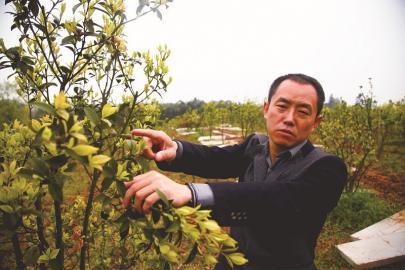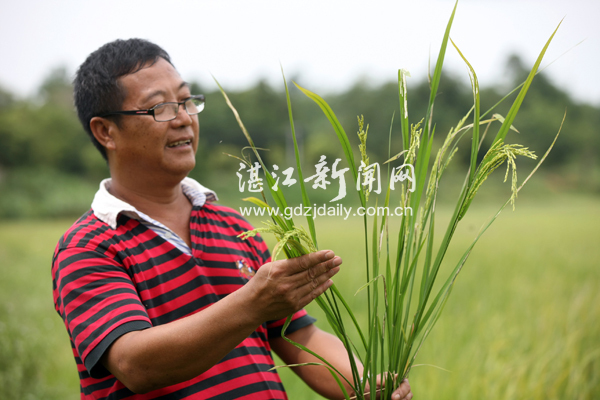Innovative interplanting owners and farmers win-win

Wang Yin inspected the seed setting of Camellia oleifera.
Innovation: the owners provide the means of production such as land, seeds and chemical fertilizers under the forest, and the villagers are responsible for managing and protecting Camellia oleifera trees and managing short-term crops.
Benefits: the camellia oleifera trees of the owners are effectively protected, and the villagers get short-term crop output benefits.
"all I have introduced are Camellia oleifera trees that have been growing for three years. The Camellia oleifera trees I bought and planted at the beginning of last year began to bear fruit this year. But it will take two years to really start to see a return. " On June 6, in Tuanjie Village, Baijie Town, Naxi District, Luzhou City, Camellia oleifera trees grew luxuriantly. Wang Yin, a villager and entrepreneur returning to his hometown, was interplanting pumpkins and taros in the base planning Camellia oleifera woodland. He said: "although the early investment in growing Camellia oleifera is large, some income can be achieved by interplanting traditional Chinese medicine or food crops to raise growth in a short time."
Interplanting can achieve some short-term income, but if it is not well managed, it may not be able to make ends meet. Wang Yin's micro-innovation is to change the mode that the owners do everything and pay the workers to provide the land, seeds, chemical fertilizers and film under the forest. The villagers are responsible for managing the crops while protecting the camellia trees and enjoy the benefits of crop output, so as to achieve a win-win situation for both the owners and the villagers.
scene
Return home to start a business and plant 5000 mu of Camellia oleifera.
Wang Yin, 40, packed his bags in the 1990s and went to Fujian, Guangzhou and other places to work hard. After working on the assembly line for more than 10 years, he went to an electronic foreign trade export company in Shenzhen to sell, and gradually developed from a salesman and department manager to one of the company's shareholders, with an annual salary of about 100000 yuan and a dividend of more than 400,000 yuan at the end of the year.
Although he earns more than 500,000 yuan a year, Wang Yin did not stop his progress. One day in April 2014, he saw from the book that Camellia oleifera had good planting prospects and thought that his hometown, where the mountains were rolling, was the planting base of extra early morning tea in China. In August of that year, he returned to his hometown with friends and, with the support of the local government, transferred 5000 mu of residual woodland to introduce Camellia oleifera.
"the choice of planting Camellia oleifera is due to the ecological and output benefits of Camellia oleifera." Wang Yin told me that tea oil is a rare woody oil unique to China, with natural quality and rich nutrition, and is known as "Oriental Olive Oil". At the same time, Camellia oleifera can also be used as organic fertilizer to extract tea saponins and make high-grade cosmetic oil and medical oil. Camellia oleifera trees in the peak period can extract 20 kg of tea oil per mu, the current selling price is more than 150 yuan / kg, the benefit is very considerable. According to Wang Yin, as the consumer group of tea oil is the middle-and high-end people in Shanghai, Guangdong and other places, the base grows strictly according to organic standards, weeding is all manual, and never touches pesticides and chemical fertilizers. In 2015, the entire Camellia oleifera base spent more than 2 million yuan on manual weeding and other expenses.
In order to plant Camellia oleifera trees well, in addition to personally participating in planting management, Wang Yin also hired oil camellia expert Zhao Xueming from the Subtropical Forestry Experimental Research Center of the Chinese Academy of Forestry Sciences as a technical consultant. Today, the Camellia oleifera in his field is growing happily. "after entering the peak period, my 5000 mu Camellia oleifera base can extract 100000 kilograms of tea oil, and the tea and oil revenue is expected to be 15 million yuan, and the base will be a green bank." Wang Yin said.
Innovative zero-cost claim to stimulate the enthusiasm of villagers. "Boss Wang, I am in charge of 20 mu of Camellia oleifera woodland on the opposite hill." "I am in charge of 15 mu." …… Recently, in the courtyard of the "two committees" of Tuanjie Village, more than 50 villagers claimed the area of interplanting pumpkins and taros under the Camellia oleifera forest this year. Soon, 1000 mu of Camellia oleifera woodland interplanted was claimed by the villagers.
"there is not a penny of rent for the land under the forest, and there is a subsidy of 100 yuan per mu. Seeds, film, and chemical fertilizer are also provided by the boss. The pumpkins and taros planted are all sold to themselves. Where can I find such a good thing?" Wang Zhenggang, a villager of three groups in Tuanjie Village, said happily after he received 15 mu of Camellia oleifera forest.
The newly planted Camellia oleifera grows slowly, and it takes at least 4-5 years to hang fruit, and the early high yield is not strong, and the economic benefit is not obvious. During this period, reasonable interplanting of low traditional Chinese medicine and crops can achieve the role of ploughing instead of caressing and short-term growth while improving soil fertility. These crops have a short planting cycle and harvest in the same year, which can effectively improve the land utilization rate, increase income, and make up for the shortcomings of long growth cycle and slow effect of Camellia oleifera.
"interplanting Chinese herbal medicines or food crops can grow in a short period of time, but if they are not well managed, they may not be able to make ends meet." In order to ensure that interplanting is rewarded, and at the same time, managers can also make profits to enhance their sense of responsibility, Wang Yin has changed from the mode of owners taking all the money to workers to provide only land, seeds, chemical fertilizer, and film. The pumpkins and taros produced are also purchased at the lowest protection price, and the management is entirely the responsibility of the farmers themselves, and they no longer pay their own wages. At the same time, in order to ensure timely management and protection of Camellia oleifera, Wang Yin gave a management subsidy of 100 yuan per mu to all villagers who claimed Camellia oleifera woodland, which greatly enhanced the enthusiasm of the villagers.
"this model is good, and we have income in addition to land rent without taking risks." Wang Zhenggang told me that the net profit of planting one mu of pumpkin or taro is 800 yuan. Coupled with the 100 yuan subsidy for the management of Camellia oleifera, the net profit per mu is at least 900 yuan, which is "much better than pure labor."
Related
- A course of planting techniques and methods on how to grow carrots
- How to plant the latest tulips?
- Is it better to pick tea in the morning or in the afternoon? When is the best time for tea to be picked? what is the third or fifth tea?
- Launch Yuanxiao Happy combination Haocha + Tea Yuan healthy Taste
- Penghu Tourism "Fireworks 20 Parade with You"
- 2022 West Lake Happiness holds "Digital Revitalization Voucher" and draws iphone13 and laptop.
- Banqiao Fuzhou social houses are designed to change start-up combined with police elimination to create a safe and livable environment
- The convenient measure of "mechanical weeding" in Xinbei has been abused and the Agriculture Bureau has imposed heavy penalties on the illegal land consolidation.
- Changgeng University Joins Hands with Four Memory Factories to Rescue Memory Talent Shortage
- The list of Taiwan's top 100 MVP managers is listed by the Director-General of the Farmers' Association of Sanxia District.



